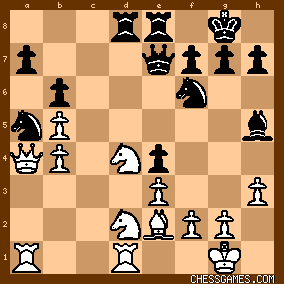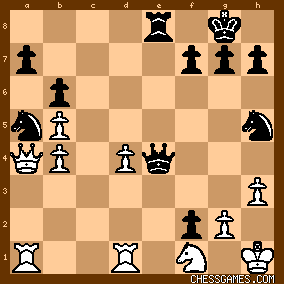| KEG: As interesting as the opening play in this game was, it pales in comparison with the violent middle-game slugfest. After 20. Nd4, Pillsbury should probably have taken Blackburne's Bishop at e2 rather than the one at b4, but he was planning an incredible attacking combination. In the following position, Pillsbury played 21...RxN: 
click for larger viewPillsbury had obviously been planning this extraordinary sacrifice for several moves. Contrary to the suggestions of commentators Hoffer and Sergeant, this was not a desperate ploy by Pillsbury to save himself in a lost position. Rather, as the players clearly recognized and as Fritz confirms, Pillsbury was very definitely in the game at this point. In the complications that followed, Blackburne had to play very accurately to avoid getting mated. Thus, after 21...RxN 22. e3xR e6 23. BxB e3xf2+, Blackburne's only move to avoid loss was 24. Kh1. Prior to Blackburne's 24. Kh1, the position was: 
click for larger viewHad Blackburne taken the pawn with 24. Kxf2, he would have been mated after 24...Qe3+. Had he played 24. Kh2, he would have been a dead duck after 24...NxB. Even after avoiding the above pitfalls by playing 24. Kh1, Blackburne faced another crisis after Pillsbury's 24...NxB. As keypusher has demonstrated, had Blackburne played the seemingly routine 25. b4xB here, Pillsbury would have had mated him in five after 25...Ng3+. In fact, Blackburne erred slightly with 25. Nf1, which avoided all of Pillsbury's mating threats, but was not as good as 25. Qa3. At this point, Pillsbury went overboard in his efforts to mate Blackburne, His 25...Qe4 was far inferior to 25...Nf4. Even here, however, Blackburne faced a nasty trap. The position was now: 
click for larger viewHad Blackburne here played 26. bxN Pillsbury would have blown him away with 26...Nf4! (as Sergeant has pointed out). But Blackburne kept his head amidst all of Pillsbury's threats and played 26. Qa2. At this stage, Fritz rates the game (1.02) in favor of Blackburne. Theoretically, Blackburne now had a won game. But Pillsbury was not done yet. He played the technically awful 26...Qf4 (instead of 26...Qh4). This is awful if you are playing a computer like Fritz. But against a human, Pillsbury had ideas that would probably wipe out most of us. After Blackburne finally (and correctly) took Pillsbury's Knight with 27. bxN, Pillsbury played 27...Re3. Had Blackburne taken the Rook with 28. 28. NxR, Pillsbury would have mated him in three moves beginning with 28...Ng3+. It was only after Blackburne's careful 28. Qd5 (28. Rd2 also wins) that he could catch his breath. Apparently, Blackburne now had the game easily in hand. He was a Rook up and had foiled all of Pillsbury's mating threats. So the game was over, right? In fact, matters were not that easy. After a small inaccuracy by Blackburne, Pillsbury managed to reduce the game to a Queen ending in which he was a pawn down. These can be tricky, but Blackburne was able to force the exchange of Queens with a few nifty Queen checks, and got himself a won K and Pawn ending. An easy win? Yes, but caution was always necessary with Pillsbury. After Pillsbury's 52...hxg6+ the position was: 
click for larger viewHsd Blackburne carelessly played 53. hxg6, Pillsbury had a draw with 53...Ke8 But Blackburne was wide awake, played 53. Kxg6, and only then did Pillsbury resign. What a great game on the part of both players! This is the kind of game I live for. | 




